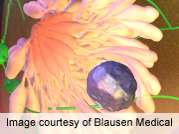Hedgehog pathway key in tamoxifen-resistant breast CA

(HealthDay)—Noncanonical Hedgehog (Hh) signaling is activated in tamoxifen-resistant tumors, and the phosphoinositide 3-kinase inhibitor/protein kinase B (PI3K/AKT) pathway plays a key role protecting Hh signaling molecules, according to a study published in the Oct. 1 issue of Cancer Research.
Noting that patients with resistance to endocrine therapy have poor outcomes, Bhuvaneswari Ramaswamy, M.D., from The Ohio State University in Columbus, and colleagues examined the role of Hh signaling in tamoxifen-resistant tumors.
The researchers found that the Hh signaling pathway was activated in tamoxifen-resistant tumors and that the PI3K/AKT pathway protected key components of the Hh signaling pathway from proteasomal degradation. In tamoxifen-resistant MCF-7 and T47D cells, the levels of Hh signaling molecules SMO and GLI1 and their targets were found to be significantly elevated. Serial passage of the resistant cells in mice led to aggressive tumors, which spread to distant organs, and simultaneous increases in Hh marker expression. SMO or GLI1 depletion mediated by RNAi correlated with reduced proliferation, clonogenic survival, and delayed transition from G1 to S. Treatment of resistant cells with PI3K inhibitors resulted in reduced SMO and GLI1 protein levels and activity, while blocking GSK3β and proteasomal degradation rescued these levels and activity. Anti-Hh compound GDC-0449 treatment of tamoxifen-resistant xenografts correlated with blocked tumor growth in mice. In a cohort of 315 patients with breast cancer, high GLI1 expression was inversely associated with disease-free and overall survival.
"In summary, our results describe a signaling event linking PI3K/AKT pathway with Hh signaling that promotes tamoxifen resistance," the authors write. "Targeting Hh pathway alone or in combination with PI3K/AKT pathway could therefore be a novel therapeutic option in treating endocrine-resistant breast cancer."
More information:
Abstract
Full Text (subscription or payment may be required)
Copyright © 2012 HealthDay. All rights reserved.














